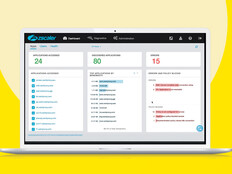The Benefits of Visibility
Information technology and its use have transformed every aspect of society. From how citizens interact with government to how countries defend themselves, the rapid growth and adoption of technology is a fundamental enabler of growth. This technology is underpinned by an intelligent network that provides the foundation for those benefits. The security and reliability of that vitally enabling infrastructure become critical factors that all government agencies must now begin to think about from the director level.
An agency, its constituents and its employees rely on the protection and privacy of their data now more than ever. In order to stay ahead of the growing threats, agencies must make a commitment to security and to trustworthy systems to enable them to protect their networks and their data, to detect intrusions and to tackle malicious events.
As today’s network threats increase in sophistication, the resulting risks to a government agency’s network may go undetected for days, months or even years. According to the Ponemon Institute’s 2015 Cost of Data Breach study, it takes an average of 256 days to identify malicious attacks. Gaining visibility into the integrity of network hardware and software is a critical first step to ensuring that IT systems are built with a foundation of trust. Non-genuine or suspect networking hardware and software are serious threats to network health and performance.
Three key threats that increase cybersecurity risks are:
- Counterfeit risks – These include hardware or software that was not built by the manufacturer or was altered after being made without consent with the intent to imitate a genuine product, as well as devices containing pirated, tampered or malicious software.
- Unauthorized channel risks – Name-brand equipment procured through an unauthorized distribution channel may be stolen or secondhand. Equipment from unauthorized channels poses a higher risk for pirated, tampered or malicious software. Unauthorized third-party components can also compromise the quality of existing equipment.
- Non-genuine software risks – Software that has been modified by an unauthorized entity can compromise the operation of the device. Malicious software can provide an attacker with the ability to monitor and exfiltrate information. Non-genuine software can also disable or “brick” hardware while attempting to perform platform maintenance or software upgrades.
Today many modern pieces of network infrastructure have capabilities built in that mitigate these risks. As technology has matured, the ability of vendors to embed capabilities that prevent or quickly identify risks posed by these key cyberthreats is becoming more prevalent. Along with many other measures, such mitigations include anti-counterfeit technologies and secure boot mechanisms to ensure nonauthorized software will not run.
Procurement through authorized channels is another critical nontechnical practice that can minimize the likelihood of these threats. Your IT network enables critical capabilities and supports core operations — all while protecting employees, citizens and intellectual property. Given the persistent threat of attack in today’s increasingly interconnected world, as well as its broadening attack surface, it is imperative that the network infrastructure itself be trustworthy.
Gaining visibility into network hardware and software integrity improves the overall security and reliability of your network infrastructure. This enhanced visibility enables proactive audits and the ability to confirm that the platform works as expected and that defenses are in place to ensure it is working effectively. Proactively identifying the devices on your network and their specific vulnerabilities that pose security risks improves risk management and satisfies compliance requirements.
For more information on network integrity verification, visit https://trust.cisco.com.









